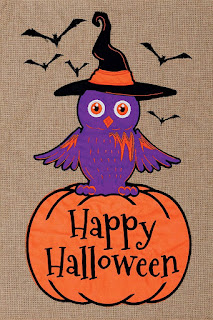 |
| Happy Halloween Garden Flag |
The word Halloween was first used in the 16th Century and throughout the ages it became associated with imagery that leans toward Gothic and horror and the supernatural associated with the night. So such things as Dracula and Frankenstein, scary ghosts and haunted houses became symbols of this harvest-time holiday in books & films, costumes, parties and products. It all makes me wonder what happened to the "Happy" in the holiday known as Halloween.
For a 'Not-So-Scary' Halloween, lets look at some friendly, fun and cute items and have a truly "Happy Halloween".
A Happy Halloween...
Can Be Found Everywhere!
On Friendly Ghosts...
Little ghost is friendly and cute - He might 'scare' himself, but his cuteness just makes you want to smile!
The Best Ghost is a 'Friendly' Ghost
Ghosts and Haunted Houses have long been associated with Halloween and are intended to Scare us. But wait, what about Casper, the Friendly Ghost? Ghosts can be friendly and fun too.
*Casper first appeared as 'The Friendly Ghost' in a 1939 children's book and a 1945 animated cartoon.
A Pair of Plush Ghosts...

Plush Toy Ghosts
Boo & Boo-ette

Boo and Boo-ette are a pair of the friendliest Ghosts you'll find anywhere. They can be friendly plush playmates for a child, or a fun Fall/Holiday decoration
Boo and Boo-ette are handmade in crochet of white acrylic yarn. The heads are lightly stuffed with soft polyfil. Their eyes are plastic 'safety eyes', giving them that Amigurumi personality. They are the creation of a crochet crafter from Kansas. This pair was in her Etsy shop and have since been sold, but contact the Etsy Shop Coastal Crochet Crafts and request your own. Custom orders always welcome.
Spooky Ghost Washcloth
 |
| Ghost Novelty Washcloth |
A ghost isn't really 'spooky' when it's in the form of a hand-crocheted cotton washcloth!
A fun novelty washcloth in the shape of a ghost. A cute way to entertain children at bath time or to make chore time in the kitchen washing dishes more fun. Or just display it for a Halloween decoration.
Bats Might be Scary...
But Not When They are Colorful and Cute Crocheted Amigurumi Baby Bats
 |
| Fritz the Fruit Bat in Crochet |
Baby Bats in Plush are Best...
...if you are seeking a non-scary Halloween.
A Baby Bat is absolutely adorable when created in the Amigurumi style of crochet. It is much cuter than those scary black bats in caves! :)
These bats are handmade and are available in the Etsy shop of Millie's Crochet House of Chesapeake, Virginia.
Baby's First Pumpkin Play Set
For babies who are too young for the 'treat or treat' of Halloween, this First Pumpkin Play Set is perfect.
My First Pumpkin Playset is by Genius Baby Toys. It is interactive with Candy Corn that crinkles, a Ghost that squeaks, a Spider rattle and a Cat that meows.
What's Your Halloween Preference?
 |
| Image Source: Wikipedia |
Do You Like a Happy Halloween or a Scary One?
Many of the Halloween Happiness Items Shown Here...
Are the crafty and artistic creations found on Etsy & Zazzle!
Related Links:
For more Halloween reviews on everything from decorations to costumes to party food, check out these articles on Review This Reviews.
© 2012 Wednesday-Elf - The Happy in Halloween was originally published on another site.
Note: The author may receive a commission from purchases made using links found in this article. “As an Amazon Associate, Ebay (EPN), Esty (Awin), and/or Zazzle Affiliate, I (we) earn from qualifying purchases.”





